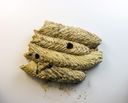Organ Pipe Mud-dauber Wasp
Trypoxylon politum
Classification
- Phylum: Arthropoda
- Subphylum: Hexapoda
- Class: Insecta
- Order: Hymenoptera
- Family: Crabronidae
- Subfamily: Crabroninae
- Tribe: Trypoxylini
- Genus: Trypoxylon
- Species: politum
Pronunciation
How to pronounce Trypoxylon politum: /trɪˈpɒksɪlən pəˈlaɪtəm/
These audio files are automatically generated. While they are not always 100% accurate, they are a good starting point.
Images






Summary
The Organ Pipe Mud-dauber Wasp (Trypoxylon politum) is a predatory wasp known for its characteristic nests resembling organ pipes. It plays a beneficial role in controlling spider populations and exhibits unique behaviors including male parental care.
Physical Characteristics
Fairly large, ranging from 3.9–5.1 cm; shiny black body with the end part of the back leg being pale yellow to white.
Identification Tips
Males emit a loud buzzing sound when their nest is approached or disturbed; nests are distinctively shaped like 'pipe organs.'
Habitat
Uses tree holes or the underside of bridges; prefers smooth, vertical surfaces with shade and protection from rainfall, close to a source of mud and adjacent to forests.
Distribution
Ranges from Southeastern Canada to the Eastern United States (MA-FL to KS-TX).
Diet
Primarily feeds on three genera of spiders: Neoscona, Araneus, and Eustala.
Life Cycle
In southern populations, T. politum has a partially bivoltine life-history, producing multiple generations that can emerge before the end of June and through the winter. In northern populations, they exhibit a univoltine pattern, producing one generation per year.
Reproduction
Males guard nests and may help females in construction; females lay eggs in mud tubes, provisioning with paralyzed spiders.
Predators
Tufted titmouse (Parus bicolor) is a known predator.
Ecosystem Role
Helps control spider populations by feeding on living, paralyzed spiders as larvae.
Health Concerns
Generally non-aggressive unless molested.
Misconceptions
Despite being wasps, they are exceedingly docile and beneficial.
Tags
- wasp
- Hymenoptera
- predatory
- mud-dauber